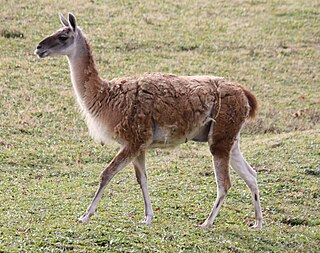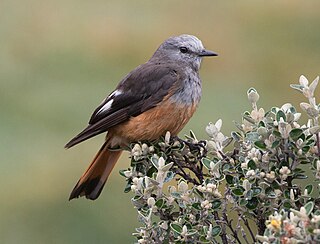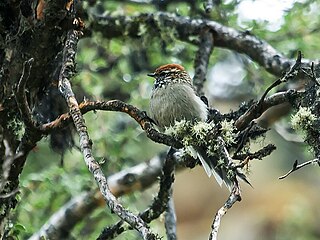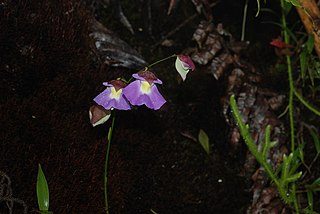
The Andes, Andes Mountains or Andean Mountain Range are the longest continental mountain range in the world, forming a continuous highland along the western edge of South America. The range is 8,900 km (5,530 mi) long and 200 to 700 km wide and has an average height of about 4,000 m (13,123 ft). The Andes extend from South to North through seven South American countries: Argentina, Chile, Bolivia, Peru, Ecuador, Colombia, and Venezuela.

The Neotropical realm is one of the eight biogeographic realms constituting Earth's land surface. Physically, it includes the tropical terrestrial ecoregions of the Americas and the entire South American temperate zone.

The Yungas is a bioregion of a narrow band of forest along the eastern slope of the Andes Mountains from Peru and Bolivia, and extends into Northwest Argentina at the slope of the Andes pre-cordillera. It is a transitional zone between the Andean highlands and the eastern forests. Like the surrounding areas, the Yungas belong to the Neotropical realm; the climate is rainy, humid, and warm.

The Tropical Andes is northern of the three climate-delineated parts of the Andes, the others being the Dry Andes and the Wet Andes. The Tropical Andes' area spans 1,542,644 km2 (595,618 sq mi).

The puna grassland ecoregion, part of the Andean montane grasslands and shrublands biome, is found in the central Andes Mountains of South America. It is considered one of the eight Natural Regions in Peru, but extends south, across Chile, Bolivia, and western northwest Argentina. The term puna encompasses diverse ecosystems of the high Central Andes above 3200–3400 m.

Polylepis is a genus comprising 28 recognised shrub and tree species, that are endemic to the mid- and high-elevation regions of the tropical Andes. This group is unique in the rose family in that it is predominantly wind-pollinated. They are usually gnarled in shape, but in certain areas some trees are 15–20 m tall and have 2 m-thick trunks. The foliage is evergreen, with dense small leaves, and often having large amounts of dead twigs hanging down from the underside of the canopy. The name Polylepis is, in fact, derived from the Greek words poly (many) plus letis (layers), referring to the shredding, multi-layered bark that is common to all species of the genus. The bark is thick and rough and densely layered for protection against low temperatures. Some species of Polylepis form woodlands growing well above normal tree line within grass and scrub associations at elevations over 5000 m; which makes Polylepis appear to be the highest naturally occurring arboraceous angiosperm genus in the world.

The fauna of the Andes, a mountain range in South America, is large and diverse. As well as a huge variety of flora, the Andes contain many different animal species.

The black-winged ground dove is a species of bird in the family Columbidae. It lives in Argentina, Bolivia, Chile, Colombia, Ecuador, and Peru and is usually found in grassy areas near tree lines but roosts in Polylepis forest and Puya colonies. Throughout most of its range, it occurs at altitudes between 2,000 and 4,400 m but between 900 and 4,900 m in Chile. It moves to lower elevations in winter

The solitary cacique or solitary black cacique is a species of bird in the family Icteridae.

The red-rumped bush tyrant is a species of bird in the family Tyrannidae. It is found in Bolivia, Colombia, Ecuador, and Peru. Its natural habitats are subtropical or tropical moist montane forests and subtropical or tropical high-altitude grassland.

The white-browed tit-spinetail is an Endangered species of bird in the Furnariinae subfamily of the ovenbird family Furnariidae. It is endemic to Peru.

Polylepis incana is a species of plant in the family Rosaceae. It is found in Ecuador, Peru, Bolivia, and possibly Colombia. It is threatened by habitat loss.

Polylepis rugulosa, the queñua, is a species of plant in the family Rosaceae. It is primarily found in the Andes region of South America in Argentina, Bolivia, Chile and Peru. It is currently threatened by habitat loss.

Roupala is a Neotropical genus of woody shrubs and trees in the plant family Proteaceae. Its 34 species are generally found in forests from sea level to 4000 m altitude from Mexico to Argentina.
Palicourea microcarpa, is a species of flowering plant in the family Rubiaceae. It is native to Bolivia and Peru.
Solanum bellum is a species of flowering plant in the family Solanaceae. It is endemic to Ecuador.

Utricularia unifolia is a species of perennial, medium-sized carnivorous plant that belongs to the family Lentibulariaceae. U. unifolia is native to Central America and western South America. It was originally published and described by Hipólito Ruiz López and José Antonio Pavón Jiménez in 1797 and later considered a synonym of Utricularia alpina until Peter Taylor's 1989 monograph on the genus where he restored the species as distinct from U. alpina. It grows as a terrestrial or epiphytic plant on moss-covered trees, rocks, or banks in cloud forests at altitudes between 2,000 m (6,562 ft) and 3,000 m (9,843 ft). U. unifolia usually produces only one leaf, which is where the species epithet "unifolia" is derived from.

The Eduardo Avaroa Andean Fauna National Reserve is located in Sur Lípez Province. Situated in the far southwestern region of Bolivia, it is the country's most visited protected area. It is considered the most important protected area in terms of tourist influx in the Potosí Department.

Escallonia resinosa is a species of evergreen shrub or tree in the family Escalloniaceae. It is native to the Andean forests of Peru, Bolivia and southern Ecuador from 2600 to 4200 meters above sea level. A component of high Andean forests, it is regarded as an important source of raw materials for the Andean peoples.

Fuchsia denticulata is a species of shrub in the family Onagraceae. It is native to Bolivia and Peru.



















